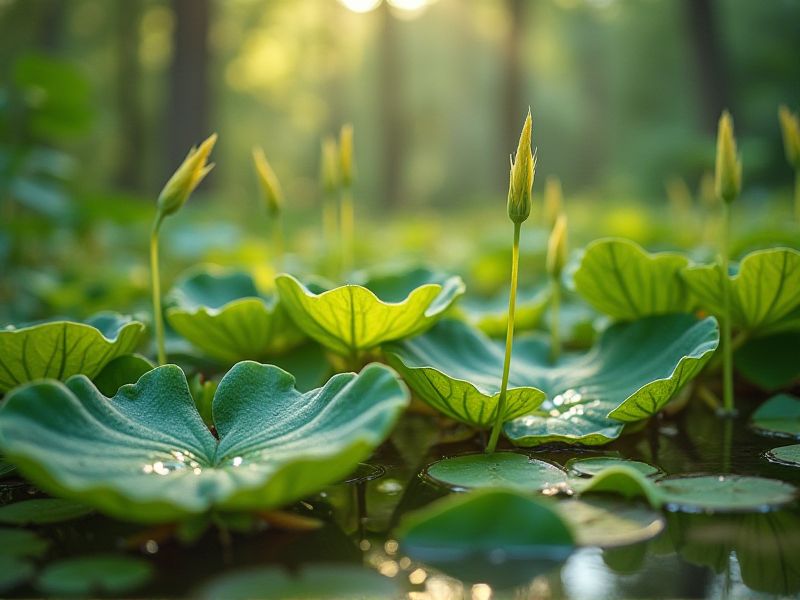
Wetland plants play a crucial role in purifying water by absorbing nutrients, heavy metals, and pollutants through their root systems. Species like cattails, bulrushes, and reeds are particularly effective in this filtration process, as they thrive in waterlogged environments. These plants also provide habitat for wildlife, stabilizing sediments and preventing erosion, contributing to overall ecosystem health. Your garden can benefit from incorporating wetland plants to enhance biodiversity while improving nearby water quality. Research shows that these plants can significantly lower levels of nitrogen and phosphorus in water, making them essential for sustainable water management practices.
List of some Wetland plants that purify water
- Common Reed (Phragmites australis)
- Cattail (Typha latifolia)
- Pickerel Weed (Pontederia cordata)
- Soft Rush (Juncus effusus)
- Water Hyacinth (Eichhornia crassipes)
- Bulrush (Schoenoplectus tabernaemontani)
- Arrowhead (Sagittaria latifolia)
- Duckweed (Lemna minor)
- Blue Flag Iris (Iris versicolor)
- Common Duck Potato (Sagittaria cuneata)
Important things about Wetland plants that purify water
Role In Nutrient Uptake
Wetland plants play a crucial role in nutrient uptake, significantly contributing to water purification processes. Species like cattails and bulrushes absorb excess nutrients, including nitrogen and phosphorus, from water, effectively reducing eutrophication. Their extensive root systems create a habitat for microorganisms that further break down pollutants and enhance the overall water quality. By fostering biodiversity, wetland plants not only improve aquatic ecosystems but also provide essential services that benefit your local environment and community.
Natural Filtration Properties
Wetland plants, such as cattails and bulrushes, play a crucial role in natural water purification through their unique filtration properties. These plants effectively absorb nutrients, heavy metals, and pollutants from the water, converting them into plant biomass and thereby improving water quality. Their extensive root systems provide habitat for beneficial microbes that further break down contaminants, enhancing the overall filtration process. By integrating these native wetland species into your landscape, you can create a powerful, eco-friendly water purification system that supports local biodiversity.
Habitat For Beneficial Microorganisms
Wetland plants function as vital habitats for beneficial microorganisms, creating a symbiotic environment that enhances water purification processes. Species such as bulrushes and cattails not only absorb excess nutrients but also provide surfaces for microbial colonization, promoting biodegradation of contaminants. The interaction between these plants and microorganisms effectively reduces pollutants like nitrogen and phosphorus, improving water quality. By fostering diverse microbial communities, wetland ecosystems support aquatic health and maintain ecological balance, underscoring their importance in natural water purification systems.
Erosion Control Capabilities
Wetland plants, such as cattails and reeds, play a crucial role in erosion control and water purification. Their extensive root systems stabilize soil, reducing the risk of sediment loss and maintaining water quality in surrounding bodies. These native species filter pollutants, nutrients, and sediments from the water, promoting a healthier ecosystem. Incorporating wetland plants into your landscape can enhance biodiversity while effectively managing erosion and improving water clarity.
Carbon Sequestration Benefits
Wetland plants play a crucial role in carbon sequestration by absorbing carbon dioxide from the atmosphere and converting it into biomass. Species such as reeds, cattails, and bulrushes not only capture carbon but also filter and purify water, removing pollutants and improving water quality. These plants enhance the natural habitat, supporting biodiversity while simultaneously mitigating climate change impacts. By restoring and preserving wetland ecosystems, you contribute to both carbon storage and the protection of vital water resources.
Biodiversity Support
Wetland plants, such as cattails, bulrushes, and pickerelweed, play a crucial role in purifying water by filtering out pollutants and excess nutrients. These native aquatic species utilize their extensive root systems to absorb harmful substances, thereby enhancing water quality and fostering biodiversity. By providing a habitat for various wildlife, including birds and amphibians, wetland plants contribute to the ecological health of their environment. Engaging in wetland conservation efforts not only protects these vital plants but also promotes sustainable ecosystems that support both flora and fauna.
Flood Regulation Function
Wetland plants play a crucial role in flood regulation by absorbing excess water and reducing runoff during heavy rainfall events. These native species, such as cattails and bulrushes, filter pollutants from water, improving its quality as it moves through ecosystems. Their interconnected root systems stabilize soil, preventing erosion and allowing for better water retention, which in turn supports local wildlife. By incorporating wetland plants into landscape designs, you can enhance natural flood management while contributing to cleaner waterways.
Phytoremediation Effectiveness
Wetland plants, such as cattails and bulrushes, exhibit remarkable phytoremediation capabilities, making them essential for purifying contaminated water. These plants absorb heavy metals, nutrients, and organic pollutants from the soil and water through their extensive root systems, effectively reducing harmful substances. By facilitating natural biological processes and supporting microbial communities, wetland plants enhance water quality and restore aquatic ecosystems. Integrating these species into water treatment strategies can significantly improve ecological health and provide sustainable solutions for water pollution challenges.
Water Temperature Regulation
Wetland plants play a crucial role in regulating water temperature and purifying water through their natural processes. Species like cattails and bulrushes absorb excess nutrients and pollutants, enhancing water quality while facilitating thermal regulation in their habitat. This plant diversity creates shaded areas, which help mitigate temperature fluctuations, benefiting aquatic life and ecosystems. By fostering healthy wetlands, you contribute to improved water clarity and overall ecological balance.
Ecosystem Health Indicators
Wetland plants, such as cattails and bulrushes, serve as vital indicators of ecosystem health by purifying water through natural filtration processes. These plants absorb excess nutrients, toxins, and sediments, helping to maintain water quality and support diverse aquatic life. Your understanding of wetland flora can reveal critical information about the ecological balance and biodiversity of the area, as the presence of various species signifies a healthy, functioning ecosystem. Monitoring these plants not only aids in assessing environmental conditions but also highlights the importance of wetlands in sustaining both terrestrial and aquatic habitats.
